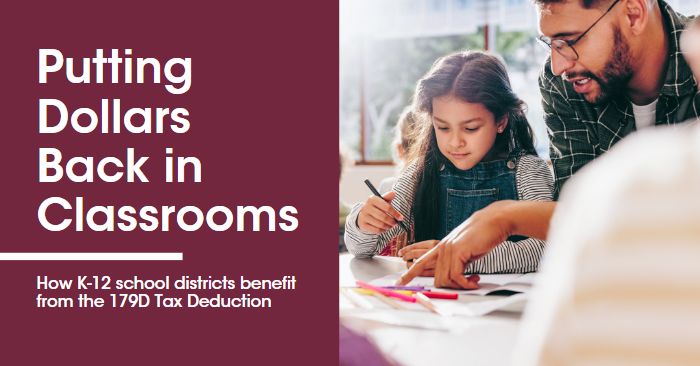School districts have traditionally resorted to private contributions from the community to raise funds for necessary projects that provide an interactive, quality education for students. While this method is proven to be effective, many leaders of K-12 school districts need to be made aware of how specific tax incentives set forth by the federal government can be used to raise funds as well.
As a result of energy incentive tax programs, like the 179D Tax Deduction, K-12 school districts have generated funds to put dollars back in the classroom and create more stimulating educational experiences for students. With the 179D Tax Deduction, school districts are now designing buildings that lay the foundation for new ways for students to receive an education.
Table of Contents:
See If You Qualify for 179D
History of the 179D Deduction
First introduced as part of the Energy Policy Act in 2005, the 179D Tax Deduction serves as a clean energy tax incentive. This initiative is designed to encourage building owners to reduce energy consumption by rewarding them with tax savings for energy-efficient building improvements.
While the Deduction was originally aimed at commercial building owners, the signing of the Inflation Reduction Act in 2022 expanded the program and its benefits to include tax-exempt entities, such as K-12 schools. By upgrading the HVAC systems, interior lighting, and building envelope, eligible projects put in place after January 1, 2023, can qualify for the maximum of $5.36 per square foot. Eligible buildings put in place in 2024 can receive up to $5.65 per square foot.
How K-12 Schools Benefit
With design rebates that school districts receive from the Deduction, school districts can put more funds back into their classrooms for educational programs and other infrastructural improvements. These extra funds can range from improved learning environments to reduced maintenance costs.
-
- Improved Learning Environment: Energy-efficient upgrades create a more comfortable and conducive classroom environment. Both students and teachers benefit from proper lighting, temperature control, and ventilation systems put in place, resulting in increased academic performance.
- Reduced Maintenance Costs: By upgrading the energy-efficiency in various buildings, school districts induce long-term operational savings through reduced energy bills and maintenance expenses. These savings lead to more resources allotted to other essential areas.
How to Claim 179D?
Because public schools are tax-exempt entities, the 179D program allows school districts to allocate the Deduction to the designers of the building through an allocation letter process. An allocation letter must be secured for a designer to receive the Deduction.
Once an allocation letter has been secured, a third-party is required to certify that the building claiming the Deduction meets the energy standards set by the IRS. This is completed by credentialed engineers using concept drawings and modeling the energy output of the building with approved software.
—
K-12 school districts play a crucial role in shaping the future by providing an engaging educational experience for its students. By leveraging the 179D Tax Deduction, schools can unlock financial savings and reinvest to create a better learning environment.
To learn more about how to put dollars back in the classroom, contact a 179D expert at KBKG today.


